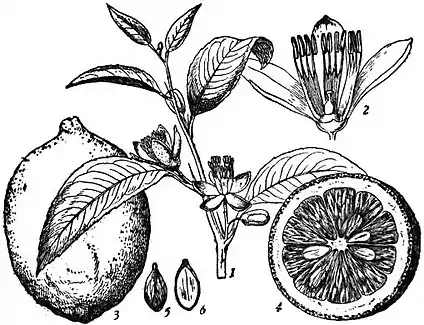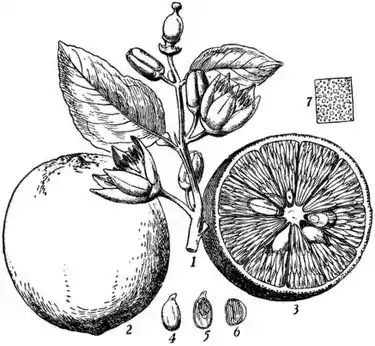LEMON, the fruit of Citrus Limonum, which is regarded by some botanists as a variety of Citrus medica. The wild stock of the lemon tree is said to be a native of the valleys of Kumaon and Sikkim in the North-West provinces of India, ascending to a height of 4000 ft., and occurring under several forms. Sir George Watt (Dictionary of Economic Products of India, ii. 352) regards the wild plants as wild forms of the lime or citron and considers it highly probable that the wild form of the lemon has not yet been discovered.

| Fig. 1.—Lemon—Citrus Limonum. | |||
| 1, | Flowering shoot. | 3, | Fruit. |
| 2, | Flower with two petals and two | 4, | Same cut across. |
| bundles of stamens removed; | 5, | Seed. | |
| slightly enlarged. | 6, | Same cut lengthwise. | |
The lemon seems to have been unknown to the ancient Greeks and Romans, and to have been introduced by the Arabs into Spain between the 12th and 13th centuries. In 1494 the fruit was cultivated in the Azores, and largely shipped to England, but since 1838 the exportation has ceased. As a cultivated plant the lemon is now met with throughout the Mediterranean region, in Spain and Portugal, in California and Florida, and in almost all tropical and subtropical countries. Like the apple and pear, it varies exceedingly under cultivation. Risso and Poiteau enumerate forty-seven varieties of this fruit, although they maintain as distinct the sweet lime, C. Limetta, with eight varieties, and the sweet lemon, C. Lumia, with twelve varieties, which differ only in the fruit possessing an insipid instead of an acid juice.
The lemon is more delicate than the orange, although, according to Humboldt, both require an annual mean temperature of 62° Fahr. (or of those which have been submitted to the action of the écuelle à piquer) on a coarse grater of tinned iron, and distilling the grated peel. The oil so obtained is colourless, and of inferior fragrance, and is sold at a lower price, while that obtained by the cold processes has a yellow colour and powerful odour.
Essence of lemon is chiefly brought from Messina and Palermo packed in copper bottles holding 25 to 50 kilogrammes or more, and sometimes in tinned bottles of smaller size. It is said to be rarely found in a state of purity in commerce, almost all that comes into the market being diluted with the cheaper distilled oil. This fact may be considered as proved by the price at which the essence of lemon is sold in England, this being less than it costs the manufacturer to make it. When long kept the essence deposits a white greasy stearoptene, apparently identical with the bergaptene obtained from the essential oil of the Bergamot orange. The chief constituent of oil of lemon is the terpene, C10H16, boiling at 348°.8 Fahr., which, like oil of turpentine, readily yields crystals of terpin, C10H163OH2, but differs in yielding the crystalline compound, C10H16+2Cl, oil of turpentine forming one having the formula C10H16+HCl. Oil of lemons also contains, according to Tilden, another hydrocarbon, C10H16, boiling at 3.20° Fahr., a small amount of cymene, and a compound acetic ether, C2H3O⋅C10H17O. The natural essence of lemon not being wholly soluble in rectified spirit of wine, an essence for culinary purposes is sometimes prepared by digesting 6 oz. of lemon peel in one pint of pure alcohol of 95%, and, when the rind has become brittle, which takes place in about two and a half hours, powdering it and percolating the alcohol through it. This article is known as “lemon flavour.”
The name lemon is also applied to some other fruits. The Java lemon is the fruit of Citrus javanica, the pear lemon of a variety of C. Limetta, and the pearl lemon of C. margarita. The fruit of a passion-flower, Passiflora laurifolia, is sometimes known as the water-lemon, and that of a Berberidaceous plant, Podophyllum peltatum, as the wild lemon. In France and Germany the lemon is known as the citron, and hence much confusion arises concerning the fruits referred to in different works. The essential oil known as oil of cedrat is usually a factitious article instead of being prepared, as its name implies, from the citron (Fr. cédratier). An essential oil is also prepared from C. Lumia, at Squillace in Calabria, and has an odour like that of Bergamot but less powerful.

| |
| Fig. 2.—Lime—Citrus medica, var. acida. | |
1, Flowering shoot. |
5, Seed cut lengthwise. |
The sour lime is Citrus acida, generally regarded as a var. (acida) of C. medica. It is a native of India, ascending to about 4000 ft. in the mountains, and occurring as a small, much-branched thorny bush. The small flowers are white or tinged with pink on the outside; the fruit is small and generally round, with a thin, light green or lemon-yellow bitter rind, and a very sour, somewhat bitter juicy pulp. It is extensively cultivated throughout the West Indies, especially in Dominica, Montserrat and Jamaica, the approximate annual value of the exports from these islands being respectively £45,000, £6000 and £6000. The plants are grown from seed in nurseries and planted out about 200 to the acre. They begin to bear from about the third year, but full crops are not produced until the trees are six or seven years old. The ripe yellow fruit is gathered as it falls. The fruit is bruised by hand in a funnel-shaped vessel known as an écuelle, with a hollow stem; by rolling the fruit on a number of points on the side of the funnel the oil cells in the rind are broken and the oil collects in the hollow stem—this is the essential oil or essence of limes. The fruits are then taken to the mill, sorted, washed and passed through rollers and exposed to two squeezings. Two-thirds of the juice is expressed by the first squeezing, is strained at once, done up in puncheons and exported as raw juice. The product of the second squeezing, together with the juice extracted by a subsequent squeezing in a press, is strained and evaporated down to make concentrated juice; ten gallons of the raw juice yield one gallon of the concentrated juice. The raw juice is used for preparations of lime juice cordial, the concentrated for manufactures of citric acid.
On some estates citrate of lime is now manufactured in place of concentrated acid. Distilled oil of limes is prepared by distilling the juice, but its value is low in comparison with the expressed oil obtained by hand as described above. Green limes and pickled limes preserved in brine are largely exported to the United States, and more recently green limes have been exported to the United Kingdom. Limalade or preserved limes is an excellent substitute for marmalade. A spineless form of the lime appeared as a sport in Dominica in 1892, and is now grown there and elsewhere on a commercial scale. A form with seedless fruits has also recently been obtained in Dominica and Trinidad independently. The young leaves of the lime are used for perfuming the water in finger-glasses, a few being placed in the water and bruised before use.